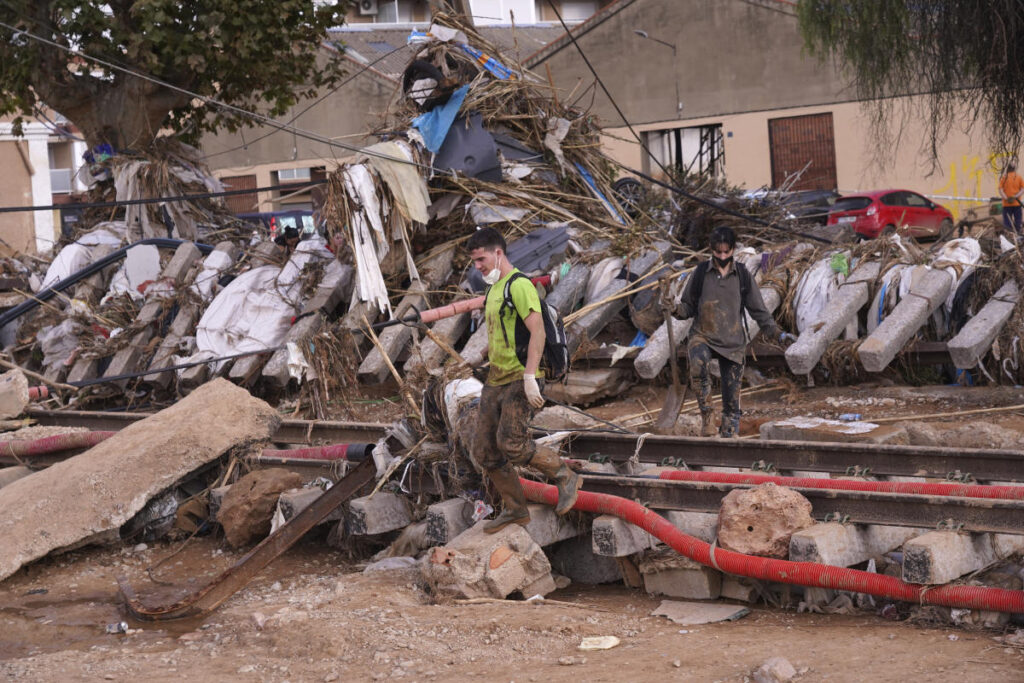The recent catastrophic torential rains in eastern Spain have led to unprecedented flash floods, significantly affecting communities in the Valencia region. This weather-related disaster, one of the deadliest the country has faced in a century, struck on October 29, resulting in devastating consequences. As officials continue to search for the dead and missing, they are also embarking on a massive cleanup and recovery effort to restore the ravaged landscapes. The flooding has claimed at least 219 lives, predominantly in Valencia, with over 93 individuals still unaccounted for. Authorities are also grappling with the tragic reality that 54 of the deceased have yet to be identified, amplifying the scale of human loss amid the chaos.
The financial impact of the floods is staggering, with estimates suggesting that damages could soar into the billions. Spain’s Consortium for Insurance Compensation projects that insurance payouts alone may exceed 3.5 billion euros (approximately $3.8 billion). This includes around 116,000 claims that have already been filed, with the majority pertaining to vehicle and home damage. The severity of the disaster and the historical nature of the flooding have prompted the Association of Insurance Companies to predict that this event will likely trigger record-setting insurance payouts. In response to the crisis, the Spanish government has committed to a 10.6 billion euro ($11.6 billion) relief package aimed at aiding families and businesses affected, while local authorities in Valencia have requested an additional 31 billion euros ($33 billion) for further assistance.
Meteorological factors played a critical role in the flooding, with two years of drought compounding the impact of record temperatures beforehand. The National Meteorological Agency recorded an astonishing 30.4 inches of rain in a single hour in the town of Turis, marking a new national rainfall record. Furthermore, the nearby village of Chiva experienced more rain in eight hours than it had over the past 20 months combined. These extreme weather patterns caused rivers and canals to overflow dramatically, creating torrents that ravaged cities and towns along their paths. Satellite imagery from the European Space Agency revealed that water inundated approximately 15,633 hectares (38,600 acres), directly affecting around 190,000 people across 78 municipalities where fatalities occurred.
In responding to this disaster, Spanish authorities have launched a massive emergency operation involving over 17,000 personnel, including both military and police forces. Among them, 8,000 soldiers, with 2,100 from specialized military emergency units, have been mobilized to support relief efforts. Local communities also rallied together, with countless volunteers providing assistance since the onset of the flooding. In the immediate aftermath, utility restoration efforts were prioritized, with 147,000 homes regaining electricity and 178,000 bottles of water distributed to areas without access to drinking water. The magnitude of this coordinated response highlights a community dedicated to overcoming the immense challenges posed by this devastating event.
Despite these concerted recovery efforts, the full extent of the disaster remains unclear. As information continues to surface, authorities have not yet disclosed how many individuals have been reported missing or provided a comprehensive assessment of property damages sustained. Additionally, no estimates have been given regarding the total land area that has been destroyed by the floods. The complexities of the recovery process raise questions about how long it will take to return to normalcy, with uncertainty lingering over the overall impact on infrastructure, the economy, and individual lives affected by this calamity.
As the situation progresses, the scale of tragedy and loss experienced in eastern Spain serves as a stark reminder of the growing challenges posed by extreme weather patterns linked to climate change. Recovery efforts remain ongoing, not only focusing on immediate needs but also considering the long-term implications of such devastation. The resilience of both the Spanish government and communities amidst this crisis will be vital in navigating the difficult road ahead as they work to rebuild lives and infrastructure, confront the continuing trend of adverse weather events, and prepare for future eventualities that may challenge their regions again.

